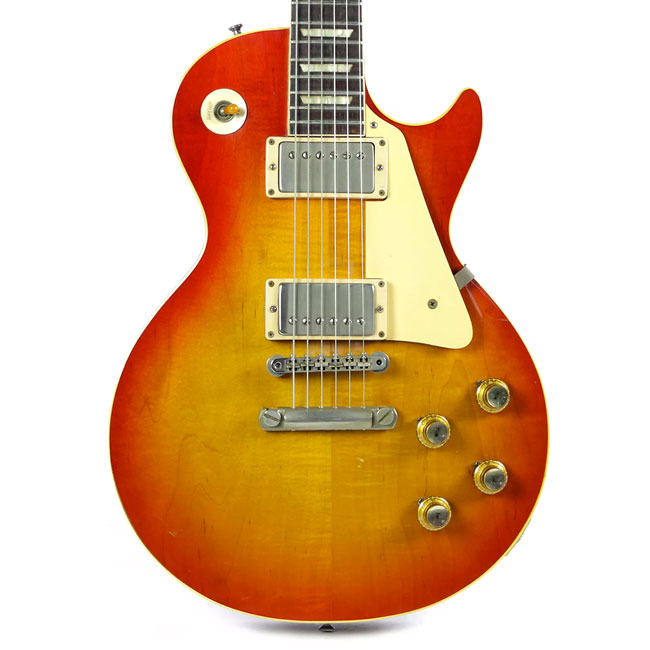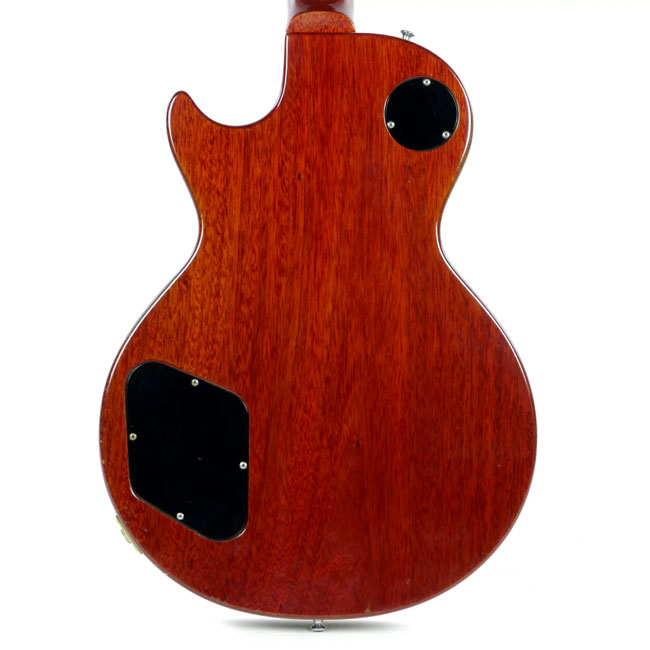Editor's note: This blog post is just one of a few pieces we have looking at the history and appeal of the Gibson Les Paul Burst. For more, see our video and article "How Many Les Paul 'Bursts' Did Gibson Really Make?" and "Inside a Burst."
An original Burst is worth its weight in gold. That’s a 1958–60 Gibson Les Paul Standard with sunburst finish—a “Burst” among those in the know—which on average weighs about nine pounds. As I write this, nine pounds of 24 carat gold will set you back around $159,000. You could pay that—and in many cases considerably more—for a Burst.
To some, this is exactly the sort of elevated value deserved for such a revered and remarkable instrument, the type played at various times by Eric Clapton, Jimmy Page, Billy Gibbons, Slash, and many more. To others, it’s all rather obscene.
You've probably heard the saying "It's only worth what someone will pay for it." You might have heard it so often, in fact, that you think of it as a bit of a cliché. Like many clichés, though, there is a nugget of truth nestling inside. In order to turn an ordinary object into a collectable of the magnitude of a Burst and to give it a great deal of added value, it ought to have rarity and it must be in demand.
Collector Mike Slubowski is lucky enough to own four Bursts: a '58, two '59s, and a '60. Does their high value affect how he feels about them? "It does have an impact on how careful I am with caring for them," Mike says. "I strive to keep them as original as possible, I store them in a safe and secure place, and I insure them as high value instruments. I do play them at rehearsals with my bandmates, but I've been reluctant to take them to any gigs for fear of damage or theft. That's a shame—but unlike my friend Joe Bonamassa, I don't have a reliable guitar tech like Mike Hickey to watch over my instruments during a gig!"

Mike observes that most desirable, collectable things have superior value attached to them. Why do Bursts come into this category?
"First, they're historical artifacts that represent post-war Americana at its best," he says. "There are a limited number of them available, and every one is different in terms of looks: the maple tops and the finishes. They were almost entirely handcrafted, and they were played by so many of our guitar heroes. They're idolized by guitarists, and many books have been written about them. I'm attracted to owning and playing vintage guitars for their intrinsic value as unique collectable instruments, and I smile every time I take one out and start playing! But I'm merely a caretaker for them at a moment in time, and I know that they'll be cherished by whoever owns them when I'm part of the Spirit in the Sky."
Let's continue our rarity-and-demand calculations. The Burst is not of the highest order of rarity: my best estimate in a piece I wrote here was a touch over 1,400 examples. So, kind of rare, but not ultra-rare. It seems both factors need to be present: rarity and demand, with demand the more important of the two. And the demand is certainly there with the Burst. It's been there almost since the legend began, when Eric Clapton bought a used Standard in 1965 and plugged it in to record the "Beano" album with the rest of John Mayall's Bluesbreakers.
The model that Clapton bought had started life in '58, when a new one sat halfway down Gibson's pricelist at $247.50. By the time it was discontinued during 1960, it had crept up $50 or so. Clapton and some of his mates in England paid around £200 (some $500 at the time) for their secondhand Bursts in the mid and late '60s, and in America players were spending anything from about $80 to $500 on them. It's clear some guitarists were already willing to pay more than the original price of this obsolete model, whether they knew it or not.
Kerry Keane headed the team at Christie's auction house in New York that staged sales of Clapton's guitars in 1999 and 2004—not including any of his original Bursts, sadly, which were long gone—and these sales are often referred to as triggers during those years for a boom in guitar collecting and, consequently, prices. Kerry, who today is an independent musical instrument consultant, says we wouldn't be talking about this instrument if it didn't sound and play better than something comparable.
"The magic here," Kerry says, "is what the instrument does for the player—it's a truly unique tool for the musician. It has the ability to deliver the sweetest and mellowest overtones when played with a light and deft touch, but it comes alive when driven to its tonal and sonic extremes. The geometry of its design and electronics make it exceedingly easy to play, and the high level of craftsmanship is not lost on the many guitarists who play one. It's become iconic with electric guitar design, popular culture, and, most importantly, with rock 'n' roll. All this, and the fact that the guitar can still serve the needs of guitarists after 60 years, is astonishing."
After Clapton and the rest popularized the Burst as a fine blues-rock tool, prices continued to rise. By the early to mid-'70s, old Bursts were in the $1,200 to $2,500 range, later climbing nearer $3,000. In the early '80s, a good one might get $5,000 and more. And here it's worth noting an important factor: The price difference can be sizable between a beaten example with no "flame" in the maple top compared to an all-round stunner. No other guitars seem to vary so much in desirability and therefore price than Bursts.


Late 1983 saw probably the first '59 Burst sold for $10,000, and by the end of the '80s, it wasn't unusual to see a nice one topping $15,000. The cost spiked in the early '90s, moving rapidly from around $20,000 to $100,000 and more by 2002, and Vintage Guitar magazine's Price Guide for 2008 showed a range of $240,000 to $420,000. Since then, the year of the economic crisis, prices have leveled to some extent.
To some, this is all madness. When I wrote a book that implied there might be a million-dollar Burst out there, some readers were appalled. "More fanciful BS from the mystic and rarified world of high-priced vintage instrument collectors," one online reviewer commented, "and how every other instrument is an inferior deviation from this particular Les Paul model. Seriously, grow up, guys."
Walter Carter of Carter Vintage in Nashville says that his regular valuation process—checking his sales records as well as checking prices online—doesn't work so well with high-dollar instruments, where there's usually less data available.
"The difficulty is compounded with a Burst," Walter says, "because, in addition to condition and provenance, you have to assess the aesthetic quality of the wood grain, which can affect value by as much as $100,000. A run-of-the-mill Burst, if there is such a thing, would probably be in the $200,000–$350,000 range, depending on the figuration of the top and the overall condition. A spectacular top or some sort of notoriety could raise the value considerably. Changed parts or finish issues would lower the value, of course. Ultimately, pricing is a combination of experience, intuition, and gut feeling."
Mike reminds us of what can be so exciting about a Burst plugged in and doing what it was built for. "They are magnificent! The neck shapes are comfortable and not too big, with some variation among them, but they're amazingly similar for something handcrafted. These guitars literally resonate in your hands. The clarity of PAFs in old wood is remarkable—each note is defined. They can get loud and strident but never muddy. They are just satisfying to play."
And what of current Burst prices, post-'08 crisis? Kerry says the vintage guitar market has returned with some vigor but become more selective and skinnier, especially at the higher end.
"I've witnessed fewer examples that are fresh on the market, leading to fewer buyers and newer collectors entering the market. With a drop off in public sales, it's harder to access reliable sale comparables. In today's market, I would expect most "flame tops" that are original but show a good amount of wear to be trading in the $275,000 to $375,000 range. I have heard of a couple of exceptionally clean examples trade privately at $650,000 and $900,000. These, of course, are outliers. What has remained constant throughout the history of this market is that any issues that compromise originality will adversely affect these values."
Walter reports on some of Carter Vintage's asking prices. "I can also tell you that we are not known for inflating prices in order to offer huge discounts," he adds with a smile. "Our highest price on a Burst was $625,000, and our lowest was $150,000. We had them both here at the same time. The prices varied so widely because the one at 625k was the very first Burst, from the original owner, and the Burst at 150k was refinished. As with many high-dollar collectables, a logical explanation of value only goes so far. A '58 Burst is exactly the same as a '57–'58 Goldtop, except for the finish, and the Goldtop with humbuckers is actually rarer than a Burst. Why is the Burst worth so much more? Well—it just is."

About the Author: Tony Bacon writes about musical instruments, musicians, and music. He is a co-founder of Backbeat UK and Jawbone Press. His books include Million Dollar Les Paul, The Les Paul Guitar Book, and Sunburst. His latest is a new edition of Electric Guitars: The Illustrated Encyclopedia (Chartwell). Tony lives in Bristol, England. More info at tonybacon.co.uk.

